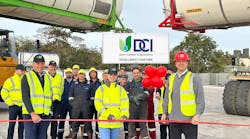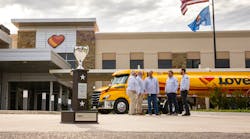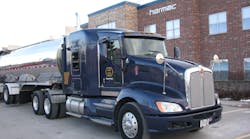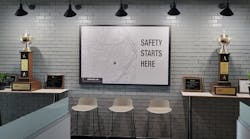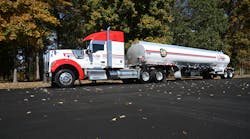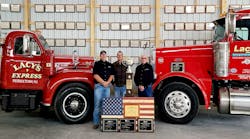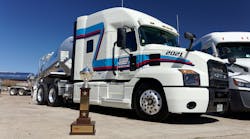THE International Liquid Terminal Association will hold its 34th Annual Conference and Trade Show June 2-4 at the Hilton Americas-Houston and George R Brown Convention Center in Houston, Texas.
This is the premier gathering of terminal industry professionals, attracting more than 3700 terminal company executives, managers, operations personnel, environmental specialists, and suppliers from around the world.
ILTA is expanding the trade show floor in 2014 to accommodate additional exhibitors. More than 320 companies from around the world will exhibit at the trade show this year
Plenary Session
On Monday, June 2 from 8:30 am-9:45 am, ILTA’s 2014 conference will begin with a discussion on shale oil developments and the movement of liquid products from these areas.
James Fallon, director of downstream energy consulting at IHS Global Inc, will provide an overview of the primary shale formations in North America and how new production techniques in these regions have led to shifts in crude and natural gas logistics in the United States. Fallon will examine capital investments in transportation and storage infrastructure in light of the shale evolution and assess the economic impacts associated with these investments. Attendees will hear how changes in transportation logistics are impacting the terminal industry.
Fallon is co-author of a report entitled Oil & Natural Gas Transportation & Storage Infrastructure: Status, Trends, & Economic Benefits released in December 2013 by the American Petroleum Institute.
Keynote luncheon
Adam Steltzner, lead landing engineer of NASA’s Mars Curiosity Rover Project, will be the keynote speaker on June 3 from 11:30 am-1:15 pm.
Steltzner, an engineer and rocket scientist at NASA’s Jet Propulsion Laboratories, made history as the lead engineer of the team that landed the Curiosity rover on Mars in 2012. His group spent nearly 10 years designing, building, testing, and tweaking the process that would lower the intricately designed, 2,000-pound rover from a speed of nearly 15,000 miles per hour and deliver it safely to the planet’s surface.
Steltzner received a PhD in engineering mechanics from the University of Wisconsin-Madison and has appeared in numerous TV documentaries about the exploration of Mars.
During his presentation, he will share his enthusiasm for science and planetary exploration and discuss how audacious goals, unbridled thinking, and breakthrough innovation can make the impossible possible.
“It’s certainly been the high point of my career . . . working on this essential phase of the mission,” he said. “It’s been an absolutely incredible experience, very gratifying.”
Steltzner’s ascension to scientific genius is pretty impressive, considering he flunked geometry and later dropped out of high school to join a rock band. His father—heir to the Schilling spice fortune—wasn’t impressed, telling him he’d be nothing more than a ditch digger.
But one night he noticed that the Orion constellation was in a different place than it had been earlier. Steltzner, suddenly fascinated by space, earned his GED and then took an astronomy class at the College of Marin in California. He was required to complete a class in physics first, and it was there he had a revelation: nature could be understood and predicted. By 1985, he quit music (playing bass and drums in a band) and devoted himself full-time to getting his bachelor’s degree in mechanical engineering and a PhD in engineering physics.
He has been portrayed in the media as a “rock ‘n’ roll” engineer. NPR’s Morning Edition said “he has pierced ears, wears snakeskin boots and sports an Elvis haircut,” while the EE Times called him “a bit of a hipster” and a “new breed of engineer” who is media savvy.
Curiosity is a car-sized robotic rover exploring Gale Crater on Mars as part of NASA’s Mars Science Laboratory mission (MSL).
Curiosity was launched from Cape Canaveral on November 26, 2011, at 10:02 EST aboard the MSL spacecraft and successfully landed on Aeolis Palus in Gale Crater on Mars on August 6, 2012. The Bradbury Landing site was less than 1½ miles from the center of the rover’s touchdown target after a 350,000,000-mile journey.
Curiosity’s design will serve as the basis for a planned Mars 2020 rover mission. In December 2012, Curiosity’s two-year mission was extended indefinitely.
Featured speaker
Jose Ramon Arango, bulk liquid specialist with the Panama Canal Authority, will appear June 2 from 12:15-1:45 pm to discuss the Panama Canal Expansion Project and the impact it will have on the bulk liquid industry. His presentation will cover the anticipated changes in global trade routes as a result of the expansion and the impact on worldwide markets.
In 2015, the expansion of the Panama Canal is expected to be completed. The expansion will double the capacity of the canal by creating a new lane of traffic and allowing larger ships to transit the waterway. US ports are preparing with infrastructure improvements of their own to accommodate post-Panamax ships.
Arango works for the Office of Market Research and Analysis of the Panama Canal Authority. He holds a Bachelor in Business Administration from Universidad Santa María La Antigua, Master Studies in Maritime Development from the School of Law at the University of Panama.
ILTA Conference page 2...
He completed executive programs in Advanced Maritime Economics and Logistics, from the Center of Maritime Economic and Logistics-Erasmus University of Rotterdam, on Pricing Strategies from The Transportation Center of Northwestern University, and on Project Management from Texas A&M University.
He has been with the Panama Canal since 1991. Until 2000, he held several positions in Canal Financial Management and Organizational Effectiveness. In 2001, he was transferred to the Office of Market Research and Analysis as an International Trade Specialist for the Liquid Bulk Segment, responsible for research, analysis and management of studies and relevant information about logistics, international trade and world economy and its impact in Canal competitiveness against other routes and liquid bulk transportation alternatives.
Monday sessions
The first morning of the conference features:
• One-hour breakout sessions at 10:05 am: “Starting Your Day Right: A Proven Approach to Enhancing Operator Performance.” Lance Fredericks, Zurich Services Corporation, and Rolf Westphal, Sprague Operating Resources; “Market Trends in Recent Terminal Sales and Expansion Projects,” Gregg Manzione, Nationwide Consulting Company; “Environmental Regulatory Compliance: How US Courts are Changing the Rules,” John King, Breazeale, Sachse & Wilson.
• Three sessions from 11:15-12:15: “Trends in Terminal Maintenance Efficiency and Effectiveness,” Brad Wood, Juran Global; “Continuous Process Improvement: A Terminal Operator’s Approach,” Colin Scott, Vopak Americas; “Optimizing Environmental Compliance Costs Through Data Analysis,” moderator Eric Kovich, Buckeye Partners, Lorna Velardi, Environmental Strategy Consultants, and Stefan Weaver, Dixon Environmental.
• Three sessions from 1:45-2:45: “Arc Flash Hazard Prevention and Compliance with the 2012 NFPA 70E Standards for Electrical Safety,” Jeffrey Gee, Conestoga-Rovers and Associates; “Evaluating Your Terminal’s Preventive Maintenance Program,” Lori Pavlish, Dow Chemical; “Emergency Planning, Response & Restoration: What Every Terminal Facility Should Know,” Nicole Franks, NJ Resources Inc., Mike Reese, National Response Corporation, and Jane Besch, Vopak Americas.
• Three sessions from 2:55-3:55: “Considerations for Fire Protection Systems at Terminals,” Skip Westbrook, Tyco Fire Protection Products; “Considerations for Implementing and Enforcing Document Retention Policies,” Pami Shandu and Courtney Crawford, Marathon Petroleum Corporation, and Karyn Layng, Scheck Industries; “Practical Application of Grounding and Bonding at Terminal Facilities,” R Chip Whitten, Lyncole Technical Services.
• Three sessions from 4:15-5:15: “Tools and Techniques for Minimizing Mistakes and Improving Compliance in Terminal Operations,” Patrick Hodgins, Buckeye Partners; and Pat Daily, Convergent Performance; “Sharing Operational Data with Your Customers: Identifying the Vulnerabilities,” Derek Welch, TransMontaigne Product Services; “ILTA Safety Award Winners Roundtable,” Eric Conard, Petro-Diamond Terminal Company, Rick DeFend, Marathon Petroleum Corporation, and Jeff Mazzoccoli, Phillips 66.
Tuesday sessions
The second morning of the conference features:
• One-hour breakout sessions at 9:20 am: “New Oil Distribution Patterns and Their Impact on Terminals,” Michael Burgett, Kinder Morgan; “Tips for Identifying Tomorrow’s Managers and Cultivating Their Leadership Skills,” Charlotte Stallings, Baker Communications; “The Revised Coast Guard Standard for Marine Vapor Control: An Overview,” Jon Young, Warner Nicholson Engineering, and Gayla Broostin, Woodbridge Engineering.
• Three sessions from 10:30-11:30: “Federal Response to Recent Shale Oil Transportation Incidents,” Tim Butters, Pipeline and Hazardous Materials Safety Administration; “Taking Initiative: Fueling the Engine of Leadership,” Walter Nusbaum, Nusbaum Inc; “Measurement of VOC Losses During Marine Vessel Loading: A Case Study,” Shanon DiSorbo, Kinder Morgan, and Brian Cochran, URS Corporation.
Post-conference workshops
• Tuesday, June 3, 2 pm-5 pm: “Air Emissions-Loading Operations,” instructor Rob Ferry, The TGB Partnership. This half-day workshop will focus on air issues pertaining directly to loading operations.
• Wednesday, June 4, 8 am-5 pm and Thursday, June 5, 8 am-2 pm: “Advanced Tanks-Air Emissions,” Ferry. This course provides a detailed look into air emissions issues relating to the design, construction, operation, and inspection of aboveground storage tanks. It will address regulatory compliance, emissions calculations, and recordkeeping and reporting requirements.
• Wednesday, June 4, 8 am-5 pm and Thursday, June 5, 8 am-2 pm: “Safe Tank Entry,” instructors Guy Colonna, PE, National Fire Protection Association, and Lamar Labauve, Delta Labs and Gas Testing. This program provides an overview of the procedures necessary to ensure safe decommissioning, degassing, entry, cleaning, recommissioning, and associated work in and around above-ground storage tanks. It will cover the basic requirements defined by the OSHA Permit-Required Confined Space Standard, NFPA 326, and API Tank Cleaning Standards 2015 and 2016.
• Wednesday, June 4, 8 am-5 pm Thursday, June 5, 8 am-2 pm: “Introduction to Terminal Operations,” conducted by ILTA. This course provides attendees with a comprehensive overview of terminal facility operations. Topics include facility design and maintenance, product handling, regulatory requirements, and industry standards. Various types of aboveground storage tanks and roof designs will be described. The workshop will also cover equipment and tank components, including seals, appurtenances, valves, pumps, meters, and loading racks. Taught by industry experts, this course is ideally suited for new terminal employees. Experienced personnel who want a review of aboveground storage tank fundamentals will also benefit from attending.
• Wednesday, June 4, 8 am-5 pm: “Fundamentals of Corrosion and Use of Control Technologies,” instructor Carlos Palacios, NACE International. This full-day, interactive workshop provides an overview of corrosion and the available methods and technologies for identifying, monitoring and controlling corrosion at terminal facilities. Attendees will learn why metals corrode and will understand the economic, environmental and safety significance of corrosion. The differences between inspection and monitoring activities relating to corrosion will also be covered. This workshop is ideal as a primer for terminal operators and environmental managers, or as a refresher for engineering personnel.
Golf tournament
The 18th annual tournament will be held at Wildcat Golf Club on June 1. ILTA’s scramble tournament is played on Wildcat’s two spectacular golf courses, the Lakes and Highlands, located just south of Houston.
On the Lakes course you start high. Its highest elevations –up to 100 feet—provide breathtaking views of Houston’s major sports complex—Reliant Stadium, home to the Houston Texans. As you work your way down you’ll see the water—acres of seemingly countless lakes. The Lakes’ dramatic elevation changes can be rivaled by no other course in Houston. Water comes into play on seven of the Lakes’ holes. Playing 7016 yards from the tips, the Lakes is a bit longer than the Highlands. You’ll enjoy navigating around the water, managing the Lakes rolling fairways and experiencing its fast greens.
At first sight, the Highlands Course offers a links golf experience, but you’ll soon discover the open tumbling fairways and impressive elevations are more typical of a Texas Hill Country course. Throughout your round, 6,954 yards from the tips, you’ll enjoy panoramic views of the city—from Houston’s Galleria area to the Medical Center, Reliant Park to Downtown. Every hole on the Highlands course offers a challenge. Protected by well-placed bunkers, lying beyond deep ravines, each pin demands your full attention. Course management will come to mind as you discover an errant shot is held captive by native grasses, or lost to a miscalculation of distance. ♦

